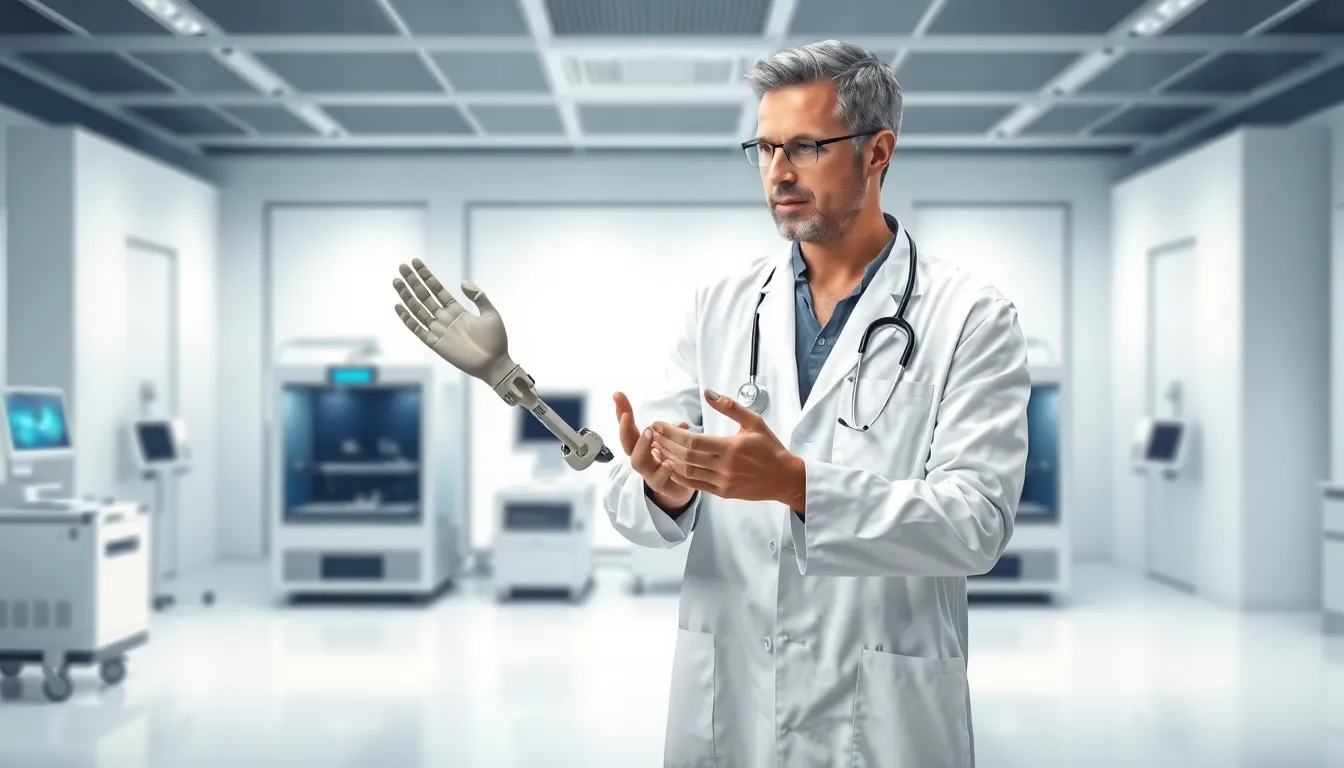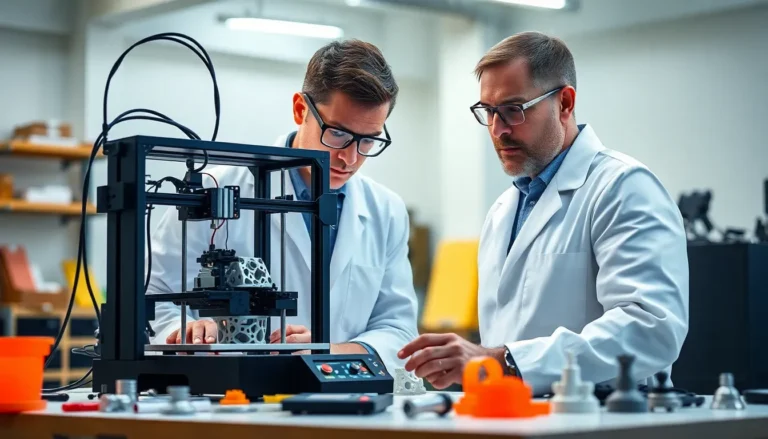In a world where technology seems to outpace even the wildest sci-fi dreams, healthcare 3D printing is the superhero we didn’t know we needed. Imagine a future where doctors can whip up custom prosthetics faster than a barista makes your morning coffee. Gone are the days of one-size-fits-all solutions; now it’s all about personalized care that fits like a glove—literally.
Table of Contents
ToggleOverview Of Healthcare 3D Printing
Healthcare 3D printing significantly enhances the medical field, allowing for the production of customized devices and solutions. This technology enables the rapid development of patient-specific models, facilitating better planning and enhancing surgical precision. Medical professionals create anatomical replicas from patient scans, which assist in preoperative assessments and simulations.
Prosthetics represent one of the most notable applications of 3D printing in healthcare. Custom prosthetic limbs provide greater comfort and functionality, allowing patients to regain mobility more effectively. Additionally, dental applications leverage 3D printing for crowns, dentures, and aligners, offering quicker turnaround times and reduced costs.
Beyond prosthetics and dentistry, 3D printing contributes to bioprinting advances, including tissue and organ development. Researchers investigate how to print viable cells that can mimic the structure and function of natural tissues. Current studies explore the potential for creating organs, a breakthrough that could address transplant shortages.
Costs associated with traditional manufacturing methods often limit accessibility to high-quality healthcare solutions. In contrast, 3D printing reduces costs related to material waste and production time. Through this streamlined process, healthcare facilities can increase their output without sacrificing quality.
Regulatory challenges still exist in this evolving landscape, as the FDA and other governing bodies work to establish guidelines for 3D-printed medical devices. Despite these obstacles, ongoing innovations highlight the promising future of this technology, reinforcing its crucial role in personalized medicine. Overall, the integration of 3D printing into healthcare continues to reshape how practitioners approach treatment and patient care.
Applications Of Healthcare 3D Printing

Healthcare 3D printing encompasses various applications that significantly enhance patient care and treatment efficiency. These innovations streamline processes and facilitate personalized medical solutions.
Prosthetics And Orthotics
Prosthetics and orthotics benefit from 3D printing through the creation of custom devices tailored to individual anatomy. This technology allows for the rapid production of prosthetic limbs that seamlessly fit patients, enhancing comfort and functionality. Many orthotic solutions can be designed to accommodate specific medical conditions, improving mobility and overall quality of life. The reduction in manufacturing time and costs makes advanced prosthetic options accessible for a broader patient base, promoting equity in healthcare solutions.
Surgical Models And Planning
Surgical models and planning see substantial improvements due to 3D printing technology. Surgeons can utilize patient-specific anatomical models to enhance preoperative planning. These models provide a clear visualization of complex structures, allowing for better anticipation of surgical challenges. Surgical teams benefit from practicing procedures on these accurate replicas, leading to improved precision during operations. This method significantly reduces the likelihood of complications and shortens recovery times for patients overall.
Bioprinting Tissues And Organs
Bioprinting creates the potential for producing viable tissues and organs, addressing critical transplant needs. Researchers employ specialized bio-inks containing living cells to construct complex biological structures. This technology lays the groundwork for developing customized organ solutions that may eventually eliminate shortages in organ transplants. Clinical trials reveal promise in using bioprinting for regenerative medicine applications. The capability to generate tissues on demand offers a new horizon in personalized healthcare.
Advantages Of Healthcare 3D Printing
Healthcare 3D printing offers various advantages that significantly enhance medical practices. These benefits involve customization, cost-effectiveness, and improved patient outcomes.
Customization And Personalization
Customization enhances patient care through tailored medical devices and prosthetics. Practitioners can create solutions that precisely fit a patient’s unique anatomy. Personalization extends to surgical planning, where 3D-printed models replicate each patient’s specific physiology. Surgeons prepare better when using these models, resulting in increased accuracy during procedures. Furthermore, this approach minimizes the risk of complications. The capacity for customization leads to increased patient satisfaction, as individuals receive treatments designed specifically for them.
Cost-Effectiveness
Cost-effectiveness becomes evident when comparing 3D printing to traditional manufacturing methods. Producing custom devices often incurs lower costs, as materials and time are optimized for each case. Healthcare facilities can save on inventory expenses by printing items as needed, reducing waste. Patients benefit from these savings with lower out-of-pocket costs for prosthetics and dental solutions. Increased production speed also decreases turnaround times, enhancing service delivery. Overall, adopting 3D printing technologies aligns financial and operational efficiencies for healthcare providers.
Improved Patient Outcomes
Improved patient outcomes directly correlate with the precision achieved through 3D printing. Personalized medical solutions increase comfort and functionality, leading to better movement for prosthetic users. Tailored surgical models empower surgeons to plan procedures accurately, which lowers complication rates. Consequently, patients experience shorter recovery times. Innovations in bioprinting add another layer of advantage by potentially producing viable tissues for transplants. This progress addresses critical shortages in donor organs, enhancing lives in the process.
Challenges In Healthcare 3D Printing
Healthcare 3D printing faces several challenges that could hinder its widespread adoption.
Regulatory Hurdles
Regulatory barriers remain a significant obstacle in healthcare 3D printing. Authorities like the Food and Drug Administration (FDA) impose strict guidelines for manufacturing processes. Compliance with these regulations can complicate and slow down innovation. Medical professionals often struggle to navigate approval processes, which can delay the introduction of new products. Ensuring safety and efficacy is crucial; however, regulations must adapt to keep pace with the rapid advancements in technology.
Material Limitations
Material constraints also limit the full potential of healthcare 3D printing. Available materials may not always provide the necessary properties for medical applications, such as biocompatibility and durability. While progress in material science has introduced new options, not all materials are suitable for every medical device or application. Researchers are continuously exploring alternatives to overcome these limitations. The development of new materials could enhance functionality and lead to better patient outcomes.
Ethical Considerations
Ethics play a critical role in the discussion surrounding healthcare 3D printing. Issues related to bioprinting complex tissues and organs raise important questions about consent and ownership. Patients must understand the implications of using printed biological materials. Moreover, equitable access to technology must be ensured to prevent disparities in healthcare. Addressing these ethical concerns is vital for fostering trust within the medical community and among patients.
Future Trends In Healthcare 3D Printing
Healthcare 3D printing is evolving, revealing exciting possibilities for the future. Innovative technologies, particularly artificial intelligence and robotics, significantly enhance this field.
Integration With AI And Robotics
AI integration streamlines the design process, allowing faster and more accurate production of medical devices. Improved algorithms analyze patient data, generating precise custom models that suit individual anatomical features. Surgical robots can assist by manipulating 3D printed tools with enhanced precision, making procedures safer. The combination of AI and robotics not only optimizes workflows but also reduces the time required for prototyping and manufacturing. Enhanced collaboration between these technologies leads to better outcomes in complex surgeries, promoting a quick recovery for patients.
Expanding Material Options
Advancements in material science broaden the possibilities of 3D printing in healthcare. Recent developments include biocompatible materials designed for implants and prosthetics, ensuring safety and efficacy. Innovative polymers and composites allow for stronger, lightweight devices that improve functionality. Researchers are exploring bio-inks that incorporate living cells, paving the way for highly personalized tissue engineering applications. By expanding material options, healthcare 3D printing can create solutions that are not just effective but also tailored to meet unique patient needs. The result is a more versatile and responsive approach to medical device manufacturing.
The advancements in healthcare 3D printing are reshaping the landscape of medical solutions. By enabling the creation of personalized devices and models, this technology not only enhances patient care but also streamlines surgical processes. As innovations continue to emerge alongside challenges like regulatory hurdles and material limitations, the potential for growth in this field remains significant.
With the integration of AI and robotics, the future of healthcare 3D printing looks promising. These developments will likely lead to even greater customization and efficiency in medical treatments. As the industry navigates these complexities, the commitment to improving patient outcomes and accessibility will drive the next phase of this exciting technological revolution.



